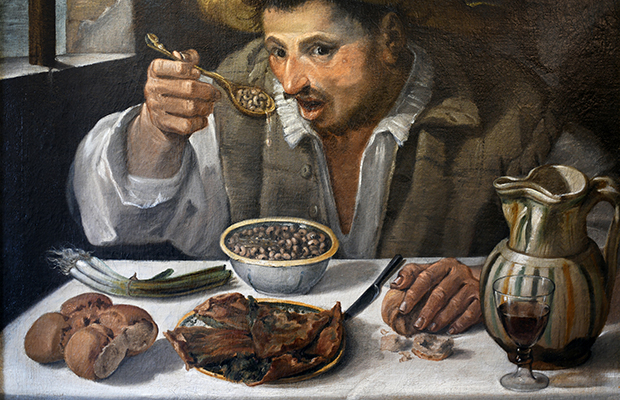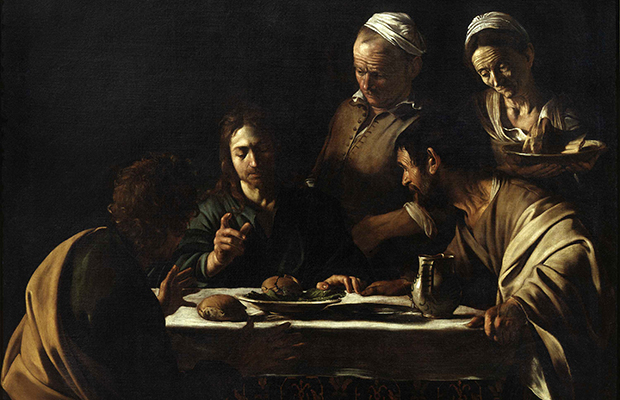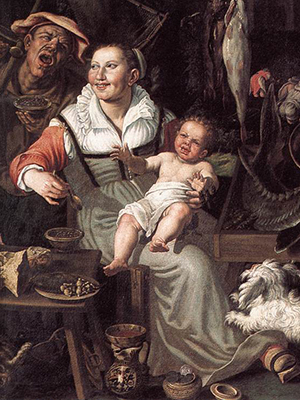Beanz meanz…

When every restaurant reviewer in the land is writing witty self-deprecating pieces about the contents of their kitchen cupboards, this column hangs its head in shame.
Mouse droppings in a pool of rancid oil from a fallen jar of anchovies and something that might once have been quince paste is shitty, not witty. The only redeeming feature is a tin of black-eyed beans.
This brings to mind the enigmatic work by Annibale Carracci, The Bean Eater, painted in the 1580s (see above image).
By this time the artist was famous for his religious paintings, with wealthy clients in Rome and his native city Bologna.
Why he should choose this apparently secular and rather low subject remains a mystery. Some think it’s a self-portrait, that close friends would recognise the battered straw hat and the characteristic greedy appetite. But the scene is not as coarse and vulgar as it seems at first sight.
Ignore the man’s dirty fingernails and messy table manners, he is wearing a freshly laundered white shirt, and eating off a nice clean tablecloth, the wine comes in a pretty maiolica jug, poured into a delicate glass, and the food on the table is far from coarse.
It sends mixed messages – the bowl of beans is everyday fare, but can be enriched with good olive oil, bacon, herbs and spices, to make a delicious dish.
The bread looks like fine white rolls, not the coarse heavy loaf of the poor, there is what might be a pie or tart of flaky pastry and spinach and ricotta, put together with care and skill, and the bunch of spring onions are, though pungent, a well-loved relish to go with simple food.
Except this food is far from simple.
You could compare it with Caravaggio’s Supper at Emmaus, 1606, where Jesus and his companions are eating at an inn, with the same carefully laid table, an elegant carafe of wine and good bread, a bowl of fruit and what looks like a pot-roast guinea fowl.

This is not bog-standard pub food, but that of a respectable hostelry, offering guests the sort of decent but not fancy food they might expect at home – weep, restaurant reviewers, weep.
Caravaggio placed this religious story in a modern setting to emphasise the Catholic church’s response to the challenge of Protestantism, bringing bible stories to everyday life and ordinary people, but by the time Carracci painted our bean eater, everyday life was an accepted topic, and we can learn a lot about food from it.
Today, as we struggle to keep food banks open, and get basic food to the less fortunate, this image speaks to us of hunger not gastronomy, the sort of desperate need to eat, that the uncouth man shows as he grabs some bread in one hand and shovels down the beans with the other, that frantic moment before the pangs of hunger subside and the enjoyment of a tasty dish can begin.
And tasty it is, for beans, fresh and dried, have been classics of Italian cooking since Roman times.

Image: Creative Commons
Another North Italian painter, Vincenzo Campi, gave us some very secular insight into bean eating in the bottom left hand corner of a larger work depicting a fish market.
The joys and hazards of beans are all too obvious, as a cheerfully vulgar couple feed themselves and a howling infant with a bowl of beans, the inevitable flatulence and incontinence emphasised in the child’s unprotected bottom, and the man’s raucous behaviour.
Black-eyed beans and peas have a long history. In Hackney, we associate them with Caribbean cooking, and many recipes can be found online, both vegan and meaty.
These beans originated in Africa, and were brought to the Caribbean and North America with the slaves who were shamefully exploited by Europeans from the 17th century onwards.
Being an easy crop to grow, and nutritious as well as tasty, black-eyed beans also became part of the subsistence diet of the poor throughout the Mediterranean.
Later, the many varieties of bean became emblematic of certain nations and cities.
Baked beans in the USA can be an exuberant, luscious dish, the humble bean losing its identity while becoming a vehicle for massive amounts of ketchup, hot sauces, rich meats and sausages. And tinned versions are nutritionally one of the store cupboard’s best hidden treasures.
The austere Tuscan bean pot, in a shape rather like a Chianti bottle, treasured and promoted by Elizabeth David, tells of a much simpler recipe, where the plump white cannellini beans of the region were, after soaking overnight, put in the pot with perhaps some treasured scraps of bacon and herbs, maybe some garlic, and left to simmer slowly in water for hours on end, the narrow neck allowing the minimum evaporation, so that the beans would not dry out as they cooked during the working day.
All they then needed was a slug of good olive oil, some chopped herbs and maybe a bit more garlic, and salt and pepper to balance the flavour of the beans.
But tinned cannellini beans are almost as tasty, quick to prepare, and as good for us as they were for Tuscan peasants, something to pile up in the kitchen cupboard, and enjoy during and after our lockdown.
Anyone wanting to know more about beans will enjoy Ken Albala’s book Beans: A History, a cheerful account of the complicated story of the bean, with over 50 recipes.
